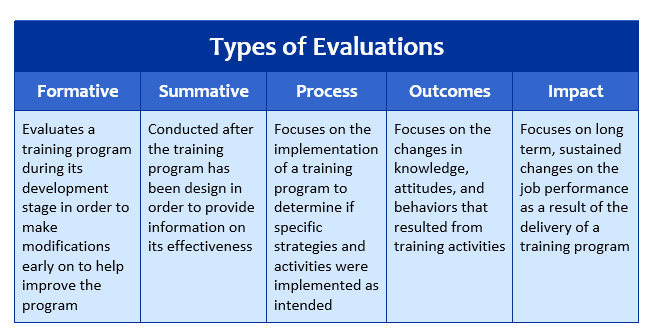Types of Evaluations
An evaluation of a training program may focuses on any of the following:
- Whether the participants benefited from the program.
- Whether the learning objectives of a training program were met.
- Whether new knowledge or skill was gained as a result of the training.
- What impact the training had on actual performance of the participants on the job.
- If the program actually meets the required business need.
Because there are various purposes for evaluating a program, there are different types of evaluation methods. It is important to understand the different types that are available and when each should be used.
In order to choose the best evaluation method for your situation, it is necessary to understand the difference between evaluation types. The main types of evaluations for training programs are:
- Formative
- Summative
- Process
- Outcomes
- Impact
Types of Evaluation
Formative Evaluation – Evaluates a training program during its development stage in order to make modifications early on to help improve the program.
Summative Evaluation – Conducted after the training program has been design in order to provide information on its effectiveness.
Process Evaluation – Focuses on the implementation of a training program to determine if specific strategies and activities were implemented as intended.
Outcomes Evaluation – Focuses on the changes in knowledge, attitudes, and behaviors that resulted from training activities.
Impact Evaluation – Focuses on long term, sustained changes on the job performance as a result of the delivery of a training program.
Formative Evaluation
A formative evaluation is a method for assessing the value of a training program while the program and its activities are being formed or in the process of being developed. It is usually conducted when a new training program is being first developed or when an existing program is being modified.
The purpose of this type of evaluation is to ensure a program and/or its activities meets the needs of the intended audience before it is fully implemented. These evaluations help catch flaws or gaps early on so that the proper modifications can be made to allow the learners to successfully acquire the intended skills and knowledge. The findings typically provide the curriculum designers and developers with information about how best to revise and modify the program or activities to obtain the desired results.
Summative Evaluation
A summative evaluation is a method of assessing the value and effectiveness of a training program at the end of the program activities (summation). The findings are used to help decide whether a program and its activities should be continued or modified for improvement.
Summative evaluations occur at the end of a program to provide an overall assessment of program effectiveness. They can help answer some of the following questions:
- Were the learning objectives met?
- Is there a need to modify the structure of the program?
- Is there a need to modify specific areas or activities?
- Should we continue the deliver the program?
The various instruments that can be used to collect the data for a summative evaluation include questionnaires, surveys, interviews, observations, and testing.
Process Evaluation
A process evaluation determines whether a training program and its activities have been implemented as intended.
These evaluations are typically conducted periodically throughout the life of the training program to address possible inefficiencies. It is used when a program is implemented to ensure that the program is efficient and effective. It can also be used during the latter stages of a program’s life to ensure it is still achieving its intended goals. Either way, these evaluations focus on how a program actually functions and assesses its materials and activities.
Outcome Evaluation
An outcome evaluation measures program effects on the target audience by assessing the outcome (learning) objectives that the program was intended to achieve. Essentially, they determine what the participants were able to do as a result of the training.
These types of evaluations focuses on the changes in knowledge, attitude, and behaviors that resulted from program’s activities. They measure what the training participants were able to do at the end of training, and what they actually did back on the job as a result of the training. These evaluations help determine whether or not the desired results of applying new skills were achieved in the short-term.
Impact Evaluation
An impact evaluation assesses a program effectiveness in achieving its ultimate business goals. They determine how well the program achieved its learning objectives, and how the results of the training affected the overall business strategic goals. Essentially, these evaluations attempt to determine the direct impact the training had on the business performance.
These types of evaluations focus on long term, sustained changes as a result of the training program. They assess what changes in the participants’ behaviors can be attributable to the training program.
Types


